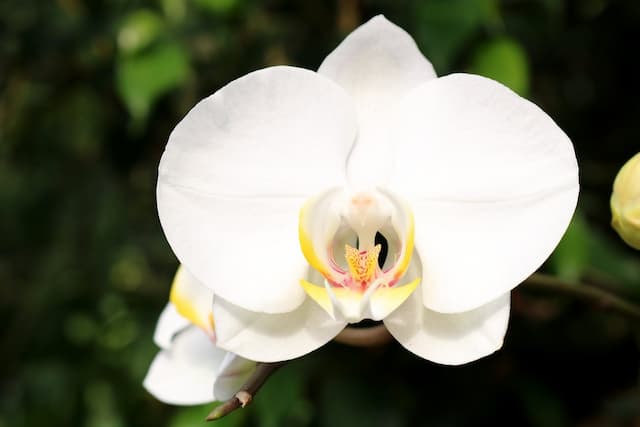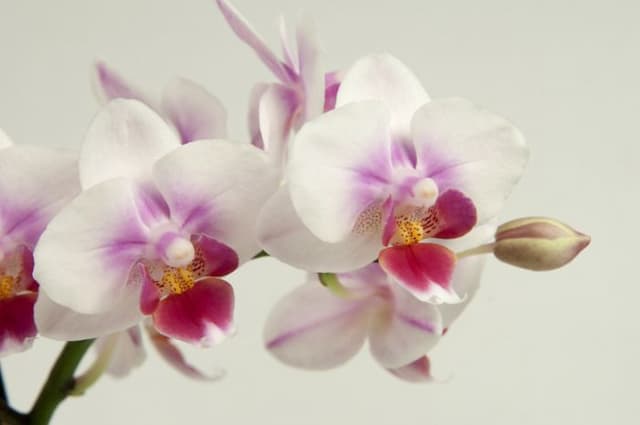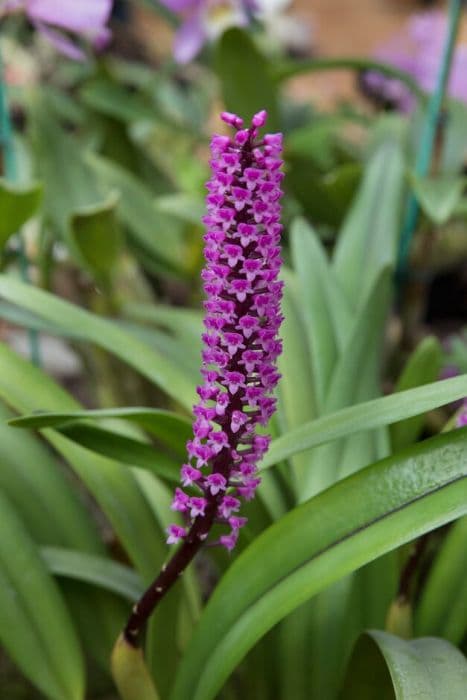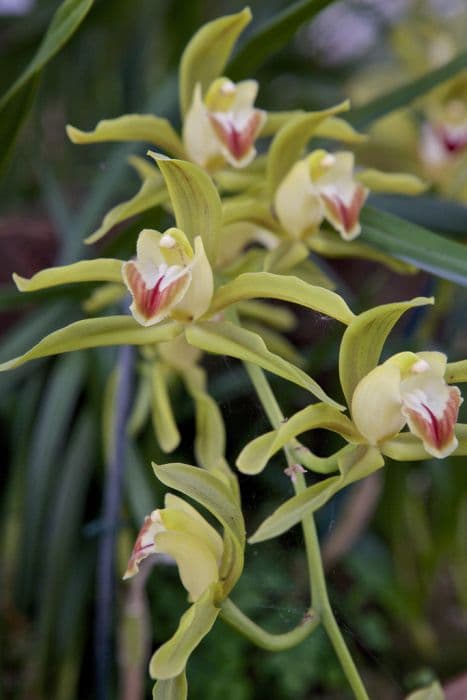Moth Orchid 'Sunny Smell' Phalaenopsis 'Sunny Smell'

ABOUT
Phalaenopsis 'Sunny Smell', commonly known as the moth orchid, is an ornamental plant renowned for its vibrant and exotic flowers. The appearance of this particular cultivar is characterized by its broad, glossy, dark green leaves that have a smooth surface and an elliptical shape, arching gracefully from a central stem. Above these leaves, the plant boasts a long, arching flower spike from which bloom several alluring flowers. The flowers of the 'Sunny Smell' are distinguished by their rounded petals and sepals, which are intricately patterned with various shades of colors, often encompassing hues of pink, white, yellow, and purple. The lip of the flower, also known as the labellum, is typically more pronounced and decorated with contrasting colors and patterns that attract pollinators in their native environment. The overall look of the flowers can be described as delicate, with a soft, velvety texture, enhancing the aesthetic appeal of this plant. What sets the 'Sunny Smell' apart from other moth orchid varieties is its fragrance. During blooming season, the flowers emit a pleasant scent that can add an extra layer of enjoyment to its ornamental value. The moth orchid is structured with a central root system that supports the plant and anchors it, usually to an aerial substrate. This root system is also essential for absorbing moisture and nutrients from the atmosphere. The roots themselves have a thick, silver-green appearance and can be seen extending beyond the growing medium. Giving a delightful display of color and scent, the 'Sunny Smell' is a cherished variety among plant enthusiasts, prized for its beauty and relatively easy care compared to other orchids, making it an attractive addition to indoor plant collections or for adorning spaces where an aesthetic touch is desired.
About this plant
 Names
NamesFamily
Orchidaceae
Synonyms
Moth Orchid, Phal
Common names
Phalaenopsis 'Sunny Smell'.
 Toxicity
ToxicityTo humans
The Moth Orchid, commonly known as Phalaenopsis 'Sunny Smell', is generally considered non-toxic to humans. Therefore, ingesting parts of this plant typically does not result in poisoning or adverse symptoms for most individuals.
To pets
The Moth Orchid, known as Phalaenopsis 'Sunny Smell', is also non-toxic to pets. It is not known to cause any symptoms of poisoning or negative health consequences if pets ingest parts of the plant.
 Characteristics
CharacteristicsLife cycle
Perennials
Foliage type
Evergreen
Color of leaves
Green
Flower color
Varies
Height
1-2 feet (30-60 cm)
Spread
1 foot (30 cm)
Plant type
Herb
Hardiness zones
10
Native area
Asia
Benefits
 General Benefits
General Benefits- Aesthetic Appeal: Adds beauty to living spaces with its elegant and long-lasting blooms.
- Low Maintenance: Requires minimal care, making it suitable for busy individuals or those new to gardening.
- Long Blooming Period: Flowers can last for several weeks, providing extended enjoyment compared to other houseplants.
- Hybrid Vigor: As a hybrid, it may be more robust and adaptable to varying indoor conditions than some species orchids.
- Mood Enhancement: The presence of flowers is known to improve mood and reduce stress levels.
 Medical Properties
Medical PropertiesThis plant is not used for medical purposes.
 Air-purifying Qualities
Air-purifying QualitiesThis plant is not specifically known for air purifying qualities.
 Other Uses
Other Uses- Artistic Inspiration: Phalaenopsis orchids, due to their unique and elegant appearance, often serve as a muse for artists and can be featured in various forms of artwork including paintings, sculptures, and fabric designs.
- Photography Subjects: These orchids can be used in macro photography to capture the intricate details and vibrant colors of their flowers, making for captivating and artistic photographic compositions.
- Educational Tools: Botany educators may use Phalaenopsis 'Sunny Smell' orchids to teach students about plant biology, hybridization, and the diversity of plant life.
- Fashion Accessories: The flowers of Phalaenopsis orchids can be incorporated into fashion, such as making temporary hair accessories or adorning hats and fascinators for special events.
- Theme Decorating: With their exotic look, these flowers can be used to create a tropical or Asian-themed decor for events like weddings or cultural celebrations.
- Jewelry Making: Real or crafted replicas of Phalaenopsis flowers can be used in making unique and delicate pieces of jewelry such as brooches, pendants, and earrings.
- Cake Decoration: Edible versions of Phalaenopsis orchid flowers can be crafted from sugar or marzipan to decorate cakes and pastries for an elegant touch.
- Greeting Cards: The image or silhouette of a Phalaenopsis orchid can be used in crafting handmade greeting cards, or as a theme for printed stationary.
- Perfume Inspiration: Although this specific orchid is not used in perfume making, its name 'Sunny Smell' suggests a fragrance, and it can inspire scents or be featured in the branding of perfume products.
- Culinary Presentation: The non-toxic flowers can serve as decorative but non-edible garnishes in upscale culinary dishes to enhance their visual appeal.
Interesting Facts
 Feng Shui
Feng ShuiThe Moth Orchid, known for its gentle and graceful blooms, can be used in Feng Shui to enhance personal growth and purification as it embodies the Wood element. Placing the Moth Orchid in the East sector of a space promotes health and family harmony or in the Southeast to attract abundance and prosperity.
 Zodiac Sign Compitability
Zodiac Sign CompitabilityThe Moth Orchid is not used in astrology practice.
 Plant Symbolism
Plant Symbolism- Love and Beauty: The Phalaenopsis orchid, commonly known as the Moth Orchid, is often associated with love and beauty, emanating an exotic and graceful appearance.
- Fertility and Abundance: Orchids in general symbolize fertility and abundance, making them popular gifts for new parents or as a symbol of growth and proliferation.
- Elegance and Sophistication: Due to their delicate and refined look, Moth Orchids are a symbol of elegance and sophistication, often present in formal occasions or as decor in luxurious spaces.
- New Beginnings & Hope: The blooming of orchids represents a fresh start or a hope for the future, making it a positive symbol for those embarking on new ventures.
 Water
WaterThe Phalaenopsis orchid should be watered thoroughly once a week, ensuring the roots are saturated but allowing excess water to drain freely. Water the plant in the morning and use room temperature water to avoid shock. Provide approximately one-quarter gallon for standard-sized pots during each watering session, adjusting for smaller or larger pots as necessary. During the hotter months, watering frequency may increase to twice a week, while in cooler months, it may reduce to once every 10 days. Always check that the top inch of the potting medium is dry before watering again.
 Light
LightMoth orchids, like Phalaenopsis 'Sunny Smell', thrive under bright, indirect sunlight. They should be placed in an east or west-facing window where they receive filtered light, avoiding direct sunlight which can scorch their leaves. A sheer curtain can be used to diffuse strong sunlight, providing the ideal lighting conditions for healthy growth and blooming.
 Temperature
TemperaturePhalaenopsis orchids prefer temperatures between 60 and 80 degrees Fahrenheit as ideal growing conditions, with nights no cooler than about 60 degrees. They can withstand a maximum temperature of up to 95 degrees and a minimum of about 50 degrees Fahrenheit. Keeping the orchid within this temperature range will promote healthy growth and flowering.
 Pruning
PruningPruning a Moth orchid involves trimming off spent flower spikes to encourage new blooms and maintaining plant health. Prune just above a node on the stem after the flowers have faded, using sterile shears. Pruning is best done immediately after the flowering period, typically only once or twice a year, depending on the plant’s blooming cycle.
 Cleaning
CleaningAs needed
 Soil
SoilThe best soil mix for the Moth Orchid is a well-draining mix, such as a combination of bark, sphagnum moss, and perlite. It should be slightly acidic to neutral, with an ideal pH range of 5.5 to 6.5.
 Repotting
RepottingMoth Orchids should be repotted every 1 to 2 years or when the potting medium begins to break down. It's best to repot after the flowering cycle.
 Humidity & Misting
Humidity & MistingMoth Orchids thrive best at a humidity level of 40-70%. They benefit from a humid environment, which can be achieved by using a humidity tray or misting the air around the plant.
 Suitable locations
Suitable locationsIndoor
Place in bright, indirect light and ensure high humidity for Moth Orchids.
Outdoor
Shelter Moth Orchids from direct sun; keep warm and humid.
Hardiness zone
10-12 USDA
 Life cycle
Life cycleThe life cycle of the Phalaenopsis 'Sunny Smell', commonly known as the Moth Orchid, begins with seed germination, which is facilitated by a symbiotic relationship with a mycorrhizal fungus. Once germinated, the seed grows into a protocorm, which eventually develops into a young orchid plant with leaves and roots. The plant matures over several years, during which it forms a larger rosette of leaves and an extensive root system. When environmental conditions are favorable, the mature orchid will produce a flowering spike, which can bear multiple flowers that last for several weeks. After pollination, which in cultivation is often done manually, the flowers will wilt and seed pods may develop, taking several months to mature before releasing numerous minute seeds. The plant can continue to grow and produce new leaves and flower spikes for many years, with some individuals flowering multiple times per year when properly cared for.
 Propogation
PropogationPropogation time
Spring-Early Summer
Phalaenopsis 'Sunny Smell', commonly known as moth orchid, can be propagated through the division of its offsets or "keikis," which are baby plants that form on the flower stalk or at the base of the plant. This form of vegetative propagation is most commonly practiced when the plant is repotting, generally in the spring after the blooming cycle when active growth is expected. When a healthy keiki has developed several roots at least 1 inch (approximately 2.5 centimeters) long, it can be carefully removed with a sterile cutting tool and potted into its own container with well-draining orchid potting medium. It's crucial to maintain high humidity around the new plant and to keep the potting medium moist but not waterlogged to encourage the keiki to establish itself.








